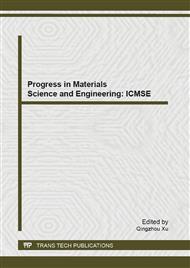p.227
p.233
p.240
p.246
p.251
p.256
p.262
p.268
p.273
Numerical Simulation and Experimental Research on the Deformation of Equal Channel Angular Pressing of Al-5Ti-1B Aluminum Alloy
Abstract:
The effective strain size and distribution of Al-5Ti-1B alloy deformed by equal channel angular pressing (ECAP) were investigated through the finite element simulation by the die with outer corner ψ=0°, 20°, 30° and the friction coefficient f=0, 0.2, 0.3. The simulation results show that the effective strains decrease with the increase of the outer corner ψ from 0° to 30° with a constant f; the more uniform deformation were obtained under the conditions of large friction than that of small friction. Al-5Ti-1B alloy was produced by once path ECAP at room temperature under the die with the corner angle φ=90° and ψ=20°. The optical microscope and compressing test machine were performed. The results indicate that the grain size was obviously refined. The yield strength increased by 37.5% from 142.0MPa to 195.3MPa, and hardness increased by 24% from 45.2HV to 55.9 HV.
Info:
Periodical:
Pages:
251-255
Citation:
Online since:
October 2013
Authors:
Price:
Сopyright:
© 2013 Trans Tech Publications Ltd. All Rights Reserved
Share:
Citation:


